2007 SUZUKI FORENZA door lock
[x] Cancel search: door lockPage 1 of 225

Part No. 99011-85Z03-03E
July, 2006
OWNER’S MANUAL
99011-85Z03-03E FORENZA
Printed in U.S.A.
For further details, see “Engine Oil” in the
“SERVICE AND APPEARANCE CARE” section.See page 5-1
Engine oil with “Starburst” symbolDOT3
ESSO LT71141 or TOTAL ATF H50235
See the “Tire Information Label” located on the driver’s
door lock pillar.
10.0 mm
2007
Made from 100% recycled paper,
except for cover.
Keep With Vehicle At All Times.
Contains Important Information
On Safety, Operation & Maintenance.
SERVICE STATION INFORMATION
Fuel recommendation: Brake and clutch fluid:
Engine oil recommendation: Automatic transmission fluid:
Tire cold pressure:
ENGLISH
Suzuki Red: Magenta 100%, Yellow 100%
Suzuki Blue: Cyan 100%, Magenta 70%
Page 5 of 225
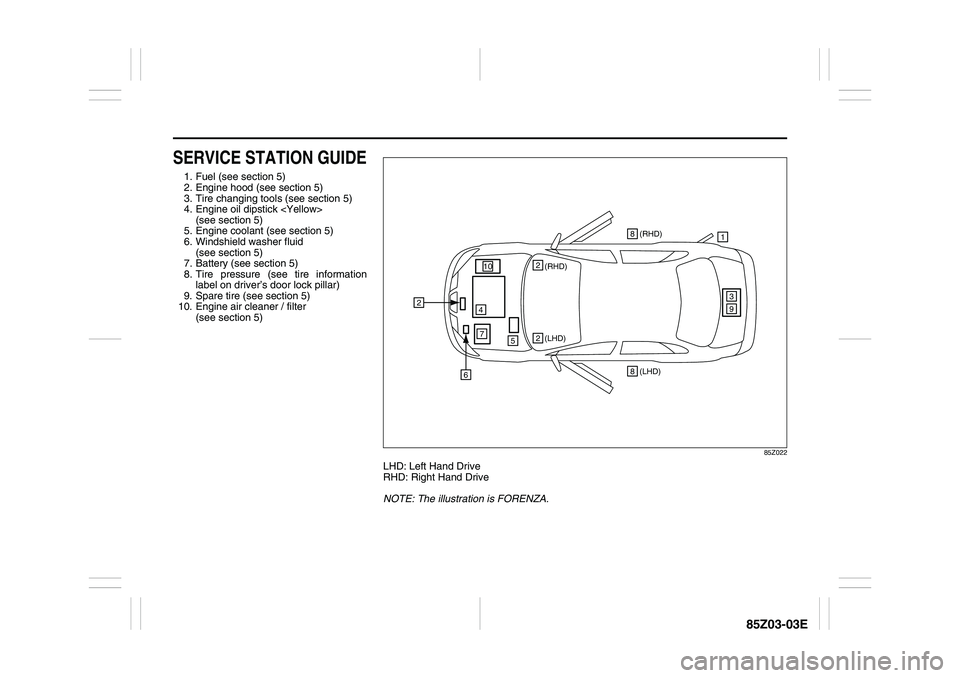
85Z03-03E
SERVICE STATION GUIDE1. Fuel (see section 5)
2. Engine hood (see section 5)
3. Tire changing tools (see section 5)
4. Engine oil dipstick
(see section 5)
5. Engine coolant (see section 5)
6. Windshield washer fluid
(see section 5)
7. Battery (see section 5)
8. Tire pressure (see tire information
label on driver’s door lock pillar)
9. Spare tire (see section 5)
10. Engine air cleaner / filter
(see section 5)
85Z022
LHD: Left Hand Drive
RHD: Right Hand Drive
NOTE: The illustration is FORENZA.
(LHD) (RHD)1
2
22
39
4
5
6
7
(LHD) 8(RHD) 8
10
Page 10 of 225

0-3
85Z03-03E
Vehicle SymbolsYour vehicle has components and labels that use symbols instead of text. Symbols, used on your vehicle, are shown along with the text
describing the operation or information relating to a specific component, control, message, gauge or indicator.
If you need help figuring out a specific name of a component, gauge or indicator, reference the following topics:
Seats and Restraint Systems in Section
1
Features and Controls in Section 2
Instrument Panel Overview in Section 3 Climate Controls in Section 3
Warning Lights, Gauges and Indicators
in Section 3
Audio System(s) in Section 3 Engine Compartment Overview in Sec-
tion 5
These are some examples of vehicle symbols you may find on your vehicle:
WARNING
POSSIBLE
INJURY
PROTECT
EYES BY
SHIELDINGFASTEN
SEAT
BELTS
POWER
WINDOWDOOR LOCK
UNLOCK DO NOT INSTALL
A REAR-FACING
CHILD RESTRAINT
IN THIS SEATING
POSITION AIR BAGMALFUNCTION
INDICATOR
LAMPENGINE
COOLANT
TEMP
FUEL
OWNER'S
MANUAL BATTERY
CHARGING
SYSTEM
BRAKE
COOLANT
ENGINE OIL
PRESSURE
ANTI-LOCK
BRAKES TURN
SIGNALS
HAZARD
WARNING
FLASHER
HIGHBEAM
ON
LIGHT
FOG
LAMPS
SULFURIC
BATTERY
ACID CAN
CAUSE
BLINDNESS
OR SEVERE
BURNS
AVOID
SPARKS OR
FLAMES
FLUSH EYES
IMMEDIATELY
WITH WATER
L3U0002CS
DOOR
AJAR
LIGHT
POWER
STEERING
FLUID
FUEL
FILLER
EMERGENCY
TRUNK
RELEASEINSTRUMENT
PANEL
BRIGHTNESS
TRUNK
AJAR
LIGHT
HOOD
RELEASEDAYTIME
RUNNING
LAMPS
TRACTION
CONTROL
SYSTEM
ACTIVE LIGHTWASHER
FLUID
TIRE
PRESSURE
WARNING
LIGHT
CRUISE
CONTROL
LIGHT
HOLD MODE
ACTIVE
LIGHT
SPEED
SENSITIVE
POWER
STEERING
WARNING
LIGHT
Page 19 of 225
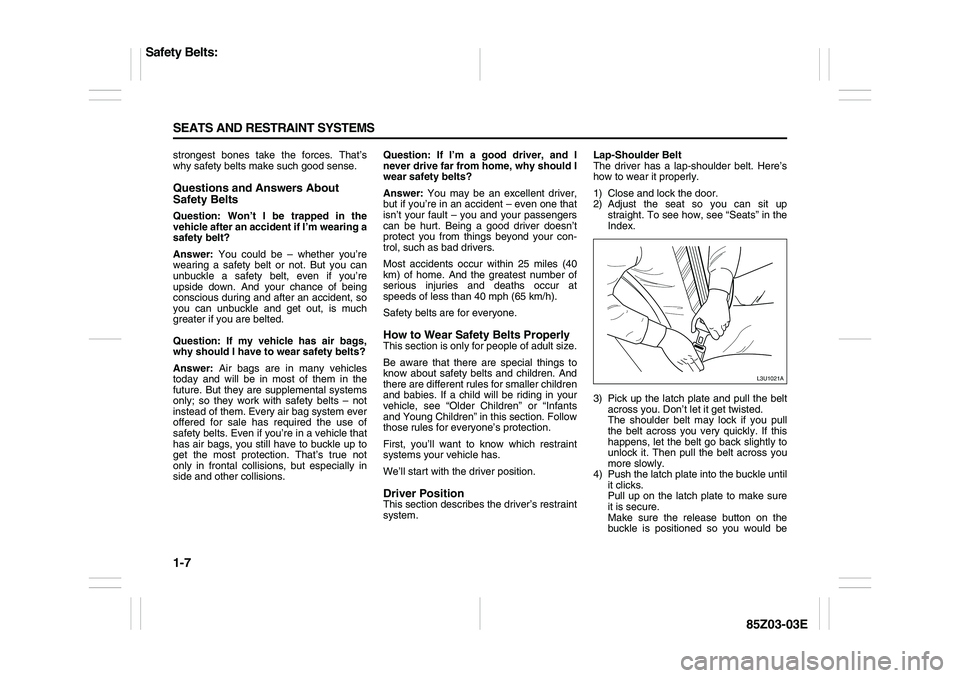
1-7 SEATS AND RESTRAINT SYSTEMS
85Z03-03E
strongest bones take the forces. That’s
why safety belts make such good sense.Questions and Answers About
Safety BeltsQuestion: Won’t I be trapped in the
vehicle after an accident if I’m wearing a
safety belt?
Answer: You could be – whether you’re
wearing a safety belt or not. But you can
unbuckle a safety belt, even if you’re
upside down. And your chance of being
conscious during and after an accident, so
you can unbuckle and get out, is much
greater if you are belted.
Question: If my vehicle has air bags,
why should I have to wear safety belts?
Answer: Air bags are in many vehicles
today and will be in most of them in the
future. But they are supplemental systems
only; so they work with safety belts – not
instead of them. Every air bag system ever
offered for sale has required the use of
safety belts. Even if you’re in a vehicle that
has air bags, you still have to buckle up to
get the most protection. That’s true not
only in frontal collisions, but especially in
side and other collisions.Question: If I’m a good driver, and I
never drive far from home, why should I
wear safety belts?
Answer: You may be an excellent driver,
but if you’re in an accident – even one that
isn’t your fault – you and your passengers
can be hurt. Being a good driver doesn’t
protect you from things beyond your con-
trol, such as bad drivers.
Most accidents occur within 25 miles (40
km) of home. And the greatest number of
serious injuries and deaths occur at
speeds of less than 40 mph (65 km/h).
Safety belts are for everyone.
How to Wear Safety Belts ProperlyThis section is only for people of adult size.
Be aware that there are special things to
know about safety belts and children. And
there are different rules for smaller children
and babies. If a child will be riding in your
vehicle, see “Older Children” or “Infants
and Young Children” in this section. Follow
those rules for everyone’s protection.
First, you’ll want to know which restraint
systems your vehicle has.
We’ll start with the driver position.Driver PositionThis section describes the driver’s restraint
system.Lap-Shoulder Belt
The driver has a lap-shoulder belt. Here’s
how to wear it properly.
1) Close and lock the door.
2) Adjust the seat so you can sit up
straight. To see how, see “Seats” in the
Index.
3) Pick up the latch plate and pull the belt
across you. Don’t let it get twisted.
The shoulder belt may lock if you pull
the belt across you very quickly. If this
happens, let the belt go back slightly to
unlock it. Then pull the belt across you
more slowly.
4) Push the latch plate into the buckle until
it clicks.
Pull up on the latch plate to make sure
it is secure.
Make sure the release button on the
buckle is positioned so you would be
L3U1021A
Safety Belts:
Page 48 of 225
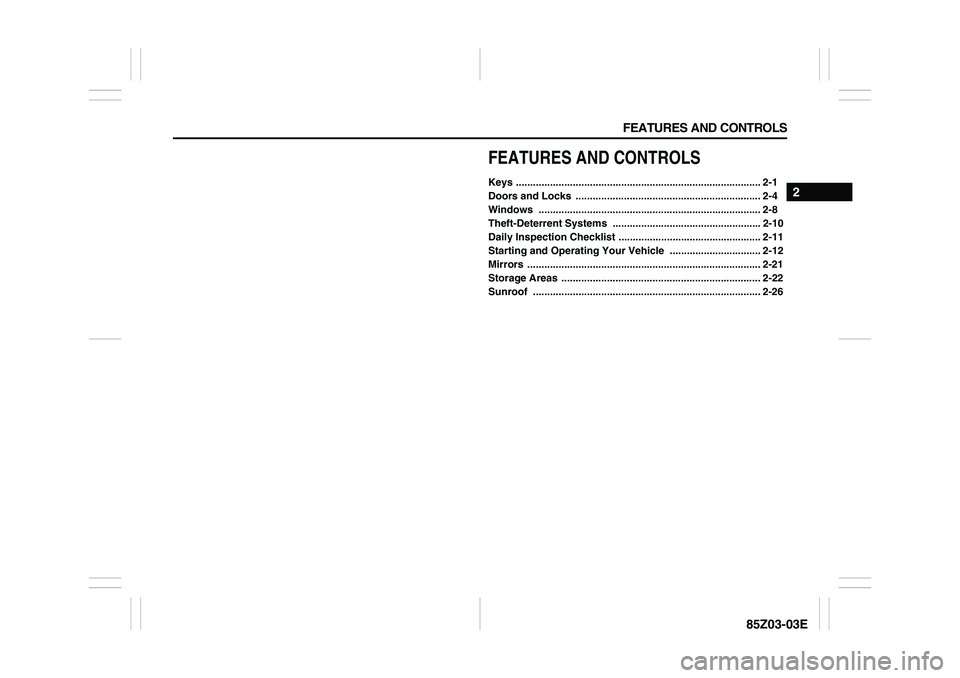
FEATURES AND CONTROLS
2
85Z03-03E
FEATURES AND CONTROLSKeys ...................................................................................... 2-1
Doors and Locks ................................................................. 2-4
Windows .............................................................................. 2-8
Theft-Deterrent Systems .................................................... 2-10
Daily Inspection Checklist .................................................. 2-11
Starting and Operating Your Vehicle ................................ 2-12
Mirrors .................................................................................. 2-21
Storage Areas ...................................................................... 2-22
Sunroof ................................................................................ 2-26
Page 49 of 225
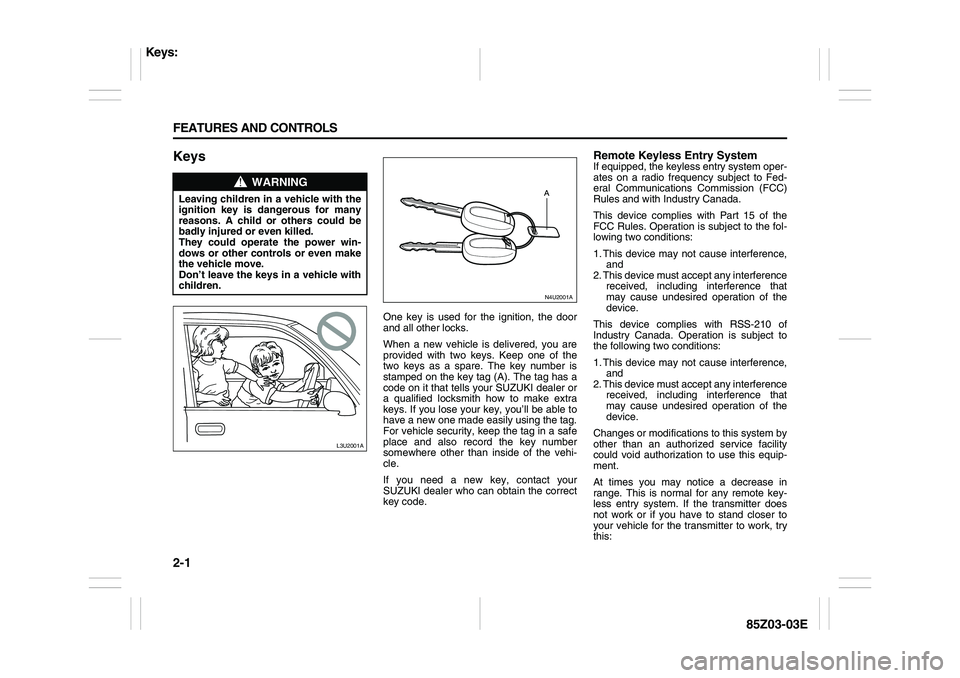
2-1 FEATURES AND CONTROLS
85Z03-03E
Keys
One key is used for the ignition, the door
and all other locks.
When a new vehicle is delivered, you are
provided with two keys. Keep one of the
two keys as a spare. The key number is
stamped on the key tag (A). The tag has a
code on it that tells your SUZUKI dealer or
a qualified locksmith how to make extra
keys. If you lose your key, you’ll be able to
have a new one made easily using the tag.
For vehicle security, keep the tag in a safe
place and also record the key number
somewhere other than inside of the vehi-
cle.
If you need a new key, contact your
SUZUKI dealer who can obtain the correct
key code.
Remote Keyless Entry SystemIf equipped, the keyless entry system oper-
ates on a radio frequency subject to Fed-
eral Communications Commission (FCC)
Rules and with Industry Canada.
This device complies with Part 15 of the
FCC Rules. Operation is subject to the fol-
lowing two conditions:
1. This device may not cause interference,
and
2. This device must accept any interference
received, including interference that
may cause undesired operation of the
device.
This device complies with RSS-210 of
Industry Canada. Operation is subject to
the following two conditions:
1. This device may not cause interference,
and
2. This device must accept any interference
received, including interference that
may cause undesired operation of the
device.
Changes or modifications to this system by
other than an authorized service facility
could void authorization to use this equip-
ment.
At times you may notice a decrease in
range. This is normal for any remote key-
less entry system. If the transmitter does
not work or if you have to stand closer to
your vehicle for the transmitter to work, try
this:
WARNING
Leaving children in a vehicle with the
ignition key is dangerous for many
reasons. A child or others could be
badly injured or even killed.
They could operate the power win-
dows or other controls or even make
the vehicle move.
Don’t leave the keys in a vehicle with
children.
L3U2001A
N4U2001A
Keys:
Page 50 of 225

2-2 FEATURES AND CONTROLS
85Z03-03E
Check the distance. You may be too far
from your vehicle. You may need to
stand closer during rainy or snowy
weather.
Check the location. Other vehicles or
objects may be blocking the signal. Take
a few steps to the left or right, hold the
transmitter higher, and try again.
Check to determine if battery replace-
ment is necessary. See “Battery
Replacement” under Remote Keyless
Entry System Operation in this section.
If you are still having trouble, see your
SUZUKI dealer or a qualified technician
for service.
Remote Keyless Entry System
OperationThe following functions are available if your
vehicle has the remote keyless entry sys-
tem:
(LOCK):
Press this button to lock all of the doors. If
all of the doors and the trunk are closed,
the hazard lamps will flash once and the
horn will chirp to indicate that locking has
occurred. The theft-deterrent system will
activate and the security indicator located
on the driver’s door lock will flash.
(UNLOCK):
Press this button to unlock all of the doors.
If all of the doors and the trunk are closed,
the hazard lamps will flash twice to indicate
that unlocking has occurred. The theft-
deterrent system will deactivate and thesecurity indicator located on the driver’s
door lock will turn off.
If a door is not opened or if the engine is
not started within 30 seconds after press-
ing Unlock on the remote keyless entry
transmitter, all of the doors will automati-
cally relock and the theft-deterrent system
will reactivate.
(TRUNK): Sedan model
Press this button for about 1 second to
open the trunk.
(PANIC): Wagon model
Press this button to turn on the panic alarm
feature. The hazard lamps will flash and
the panic alarm will stay on for about 28
seconds unless you press the Panic button
again.
The LED (A) on the transmitter will flash
when the transmitter button is pressed.
The Lock, Unlock and Trunk buttons will
not operate and the theft-deterrent system
will not activate while the key is in the igni-
tion.
Matching Transmitter(s) to Your Vehicle
Each remote keyless entry transmitter is
coded to prevent another transmitter from
unlocking your vehicle. If a transmitter is
lost or stolen, a replacement can be pur-
chased through your SUZUKI dealer.
Remember to bring any remaining trans-
mitters with you when you go to your
N4U2002B
(A)
(A)
(Sedan) (Wagon)
Keys:
Page 52 of 225
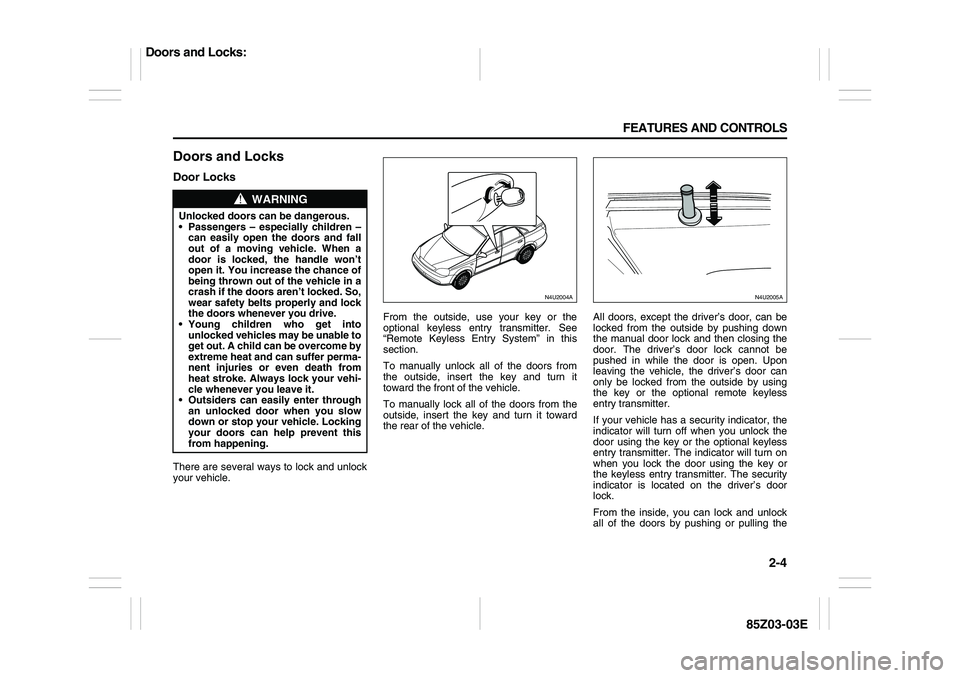
2-4 FEATURES AND CONTROLS
85Z03-03E
Doors and LocksDoor LocksThere are several ways to lock and unlock
your vehicle.From the outside, use your key or the
optional keyless entry transmitter. See
“Remote Keyless Entry System” in this
section.
To manually unlock all of the doors from
the outside, insert the key and turn it
toward the front of the vehicle.
To manually lock all of the doors from the
outside, insert the key and turn it toward
the rear of the vehicle.All doors, except the driver’s door, can be
locked from the outside by pushing down
the manual door lock and then closing the
door. The driver’s door lock cannot be
pushed in while the door is open. Upon
leaving the vehicle, the driver’s door can
only be locked from the outside by using
the key or the optional remote keyless
entry transmitter.
If your vehicle has a security indicator, the
indicator will turn off when you unlock the
door using the key or the optional keyless
entry transmitter. The indicator will turn on
when you lock the door using the key or
the keyless entry transmitter. The security
indicator is located on the driver’s door
lock.
From the inside, you can lock and unlock
all of the doors by pushing or pulling the
WARNING
Unlocked doors can be dangerous.
Passengers – especially children –
can easily open the doors and fall
out of a moving vehicle. When a
door is locked, the handle won’t
open it. You increase the chance of
being thrown out of the vehicle in a
crash if the doors aren’t locked. So,
wear safety belts properly and lock
the doors whenever you drive.
Young children who get into
unlocked vehicles may be unable to
get out. A child can be overcome by
extreme heat and can suffer perma-
nent injuries or even death from
heat stroke. Always lock your vehi-
cle whenever you leave it.
Outsiders can easily enter through
an unlocked door when you slow
down or stop your vehicle. Locking
your doors can help prevent this
from happening.
N4U2004A
N4U2005A
Doors and Locks: